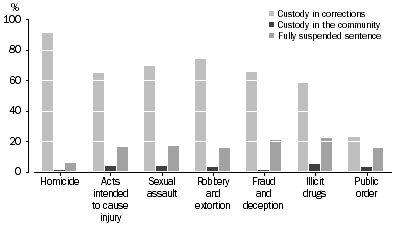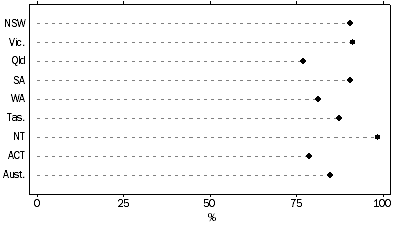SENTENCE OUTCOMES
The following information relates to sentence outcomes for defendants heard in the Higher Courts. Defendants are referred to as 'convicted' where they were proven guilty of at least one of the final charges laid against them. Sentence refers to the principal sentence a defendant received (refer to Explanatory Notes paragraphs 45-47 for further information).
Differences in sentencing are a result of the offence the defendant was convicted of, as well as a range of aggravating and mitigating factors taken into account by the court, such as prior convictions, level of violence, whether the offender was provoked, and demonstrations of remorse. The range of sentences available also differs across states and territories.
Custodial orders
The majority (85% or 11,184) of defendants proven guilty in 2009-10 received a custodial order. This proportion had increased since 2001-02 when it was 72%. Of defendants proven guilty, 63% were sentenced to custody in a correctional institution; 4% to custody in the community; and 18% were granted fully suspended sentences. These proportions had not changed from 2008-09.
Defendants convicted of homicide offences were most likely to receive a sentence of custody in a correctional institution (91%), followed by those defendants convicted for robbery (74%) and sexual assault (70%) (Table 2.7).
DEFENDANTS PROVEN GUILTY, Selected principal offence by custodial sentence

A greater proportion of males proven guilty received a sentence of custody in a correctional institution than females (65% compared with 48%). A larger proportion of convicted females were given fully suspended sentences than males (24% and 17% respectively) (Table 2.8).
The proportion of defendants proven guilty receiving a custodial order varied across states and territories, ranging from 77% in Queensland to 98% in the Northern Territory (Table 2.3).
DEFENDANTS PROVEN GUILTY, Custodial orders by states and territories

Non-custodial orders
Defendants sentenced to non-custodial orders (community supervision or work orders, monetary orders and other non-custodial orders) accounted for 15% (2,009) of defendants proven guilty in the Higher Courts, the same proportion as in 2008-09 (Table 2.2).
Community supervision or work orders were most commonly issued to defendants convicted of public order offences (22%) and property damage and environmental pollution (21%). A greater proportion of defendants convicted of public order offences (16%) received monetary orders than defendants convicted of other offences (Table 2.7).
DEFENDANTS PROVEN GUILTY, Selected principal offence by non-custodial sentence

The proportion of convicted females receiving community supervision or work orders (15%) is almost double the proportion of males (8%). A larger proportion of male and female convicted defendants under 20 years of age received a non-custodial order (27% and 51% respectively), compared with other age groups (Table 2.8).
 Print Page
Print Page
 Print All
Print All